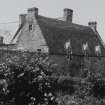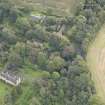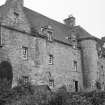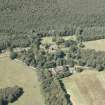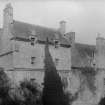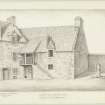Fountainhall
Country House (17th Century), Pillory (Post Medieval), Sundial (17th Century), Walled Garden (Post Medieval)
Site Name Fountainhall
Classification Country House (17th Century), Pillory (Post Medieval), Sundial (17th Century), Walled Garden (Post Medieval)
Alternative Name(s) Penkaet Castle
Canmore ID 54713
Site Number NT46NW 21
NGR NT 42659 67712
Datum OSGB36 - NGR
Permalink http://canmore.org.uk/site/54713
- Council East Lothian
- Parish Pencaitland
- Former Region Lothian
- Former District East Lothian
- Former County East Lothian
NT46NW 21.00 42659 67712
NT46NW 21.01 42528 67625 Cottages
NT46NW 21.02 42567 67666 Stables
NT46NW 21.03 42539 67635 Cottages
NT46NW 21.04 42535 67631 Cottages
NT46NW 21.05 42523 67621 Cottages
NT46NW 21.06 42515 67616 Cottages
NT46NW 11 4270 6765 Dovecots
NT46NW 48 42633 67642 Gatepiers
NT46NW 49 42476 67648 Well
NT46NW 50 42712 67609 Offices
(NT 42659 67712) Penkaet Castle (NAT)
OS 6" map (1970)
This is a small mansion of the late 16th century, prolonged in the early 17th century on the same scale and in the same materials. The earliest part is the W end; one room thick with a projecting stair-turret, it was probably built soon after 1685 (2 - sic; ? 1585 intended); the ridge chimney and crowsteps show where it once stopped. The turret was afterwards widened, filling in the small re-entrant angle to the W, with a corbel course above the first floor, then another storey and a dormered attic. In the E angle a round stair-turret is corbelled out over the entrance; its roof and the adjacent gable have been modified. The next principal stage of the building was the much lower range to the E, originally separate, with gables to N and S, and access to the dormered upper floors by an outside stair. This was the work of John Pringle, who bought the estate in 1635. His initials appear on one of the dormers with the date 1638. He subsequently continued the original building to join up with it, providing a round stair-turret at the back of the link and probably adding the pedimented dormers all round. He may have been responsible for the enhancement of the W end as well. In 1685 the the estate was bought by John Lauder of Newington, and the house, previously known as Woodhead, became the seat of the barony of Fountainhall. It is only in recent years that the name has been changed to Penkaet Castle (J Whitaker 1938).
The jougs attached to the S wall were formerly attached to the dovecot described on NT46NW 11.
Tranter (1962) suggests that the original house here may have been a small free-standing tower of earlier date than the 16th century. Adjoining the house on NW and E are extensive walled gardens with an early 17th century gateway.
C McWilliam 1978; RCAHMS 1924, visited 1920
Penkaet Castle is generally as described. The 17th century gateway is at NT 4269 6770.
Visited by OS (BS) 21 October 1975
NMRS REFERENCE:
Owner: Mr Cowe
Typescript History by A R Dufty c.1955
Deposited by A R Dufty, 1989.
EXTERNAL REFERENCES:
Scottish National Portrait Gallery:
National Art Survey - 12 sheets
Scottish National Portrait Gallery:
Country Life Dec. 2nd 1954 - article and photographs
National Library:
Small's 'Castles and Mansions of the Lothians' - article and photograph
Measured Survey (1866 - 1921)
The architect Sir Robert Rowand Anderson, founder of the Edinburgh School of Applied Art, initiated the National Art Survey of Scotland in 1866 to create a library depicting the best examples of Scottish Architecture from which students could take inspiration. Two bursars, selected from the best draughtsmen trained by the school were appointed each year. In 1903 the Edinburgh School of Applied Art joined with the Board of Manufacturer's School of Art to found the Edinburgh College of Art and the bursaries were continued there. The majority of the drawings were made by architectural students between 1895 and 1906.
The National Art Survey of Scotland Collection comprises around 1500 measured survey drawings by a number of different draughtsmen, many of whom later became well known architects, including Ramsay Traquair and Peter Macgregor. They cover a wide range of buildings from across Scotland including castles, tower houses, churches and urban structures, as well as decorative details, plasterwork and furniture.
Field Visit (9 April 1920)
A very complete example of a small 17th century Scottish mansion is to be found in Fountainhall (fig. 127), which occupies a sheltered and retired position rather more than a mile to the southwest of Wester Pencaitland. It is still inhabited and is in an unusual state of preservation, for it retains internally much of the original 17th century woodwork and rather later furniture, while externally only such work as was necessary for conservation has been carried out since completion. The building sits close to the ground and comprises a long central block, with main axis lying north-east and south-west, two storeys and an attic in height; at either end a wing projects southwards, the eastern being the longer, narrower and lower. The wing on the west is three storeys arid an attic in height and with the western 21 feet of the central block comprises the earliest portion; it may date from the last years of the 16th century, while the east wing, which is dated 1638, is the latest, but, as the detail throughout is identical and of the type current between 1625-1650, the building may be described as though it were entirely of this one period. The close resemblance in detail between Fountainhall and the Hamilton house at Preston (No. 158 [NT37SE 4]) suggests that they came from the same hands. The greatest dimensions of the building are 104 ½ feet along the north wall by 48 ¾ feet along the east wall.
The building is of light coloured freestone rubble covered with harling except at the dressings, which are exposed. The windows have dressed and backset margins chamfered at jambs and lintel. The dormer windows have moulded horizontal and raking cornices enclosing triangular pediments, which are surmounted by sadly decayed finials trefoiled or crescented. One only of the pediments is inscribed, that of the dormer on the east wing. It bears the date 1638 above initials in monogram I. P. M. D. for John Pringle, son of Robert and his wife, Margaret Dickson. The date is repeated on the south-east skewput of the same wing; beneath this date are the initials R. P. for Robert Pringle. The north-east skewput bears the same initials. On the north-east skewput of the main building is a worn monogram which may be read R. P. V. C. R and C being certain, and so may stand for Robert Pringle and Violet Cant, his wife. The northeast angle of the east wing is chamfered off below a corbelling, under which is a shield inscribed 1638 IVLIE 21, probably the date at which this part was constructed. In the southeast re-entering angle there is a circled turret now curtailed in height, borne on the usual moulded conoidal corbelling. The upper portion of the south wall of the west wing overhangs wall is angled. The south-west angle bears a projecting sundial (1) set about the level of the attic floor.
[for a full architectural description see RCAHMS 1924, 86-9, figs. 127-131]
HERALDIC PANEL. A late 17th century stone panel is inserted in the attic wall of the western wing just beneath the roofing. It has been fractured and is incomplete. Within a moulded border enriched with a cable ornament is a shield charged with a griffin salient within a bordure (Lauder); the shield is supported by lions, and beneath is the initial L for Lauder. This stone has no connection with Fountainhall, and is said to have been brought from the Bass to be inserted in the empty panel space above the garden door.
JOUGS. A pair of jougs with chain and staple, which were formerly secured to the dovecot, are now attached to the exterior of the south wall.
HISTORICAL NOTE. The barony of Fountainhall was constituted in 1685 in favour of John Lauder of Fountainhall, a merchant burgess of Edinburgh, who was known also as of Newington, and Sir John Lauder, advocate, his son. The lands comprised Easter and Wester Templehall to the south, Huntland to the east and Dryburgh lands, and had previously belonged to a family of Pringle of Woodhead or Southwood, the King having in 1636 granted to Robert Pringle, Writer to the Signet, his wife, Violet Cant and John Pringle his son and heir these lands including Southwood alias Woodhead, after resignation by George Cockburn of Ormiston. Robert Pringle was the builder of the present house, then known, therefore, as Woodhead, and was succeeded in Woodhead by John Pringle and another John before the whole property was disposed of to Lauder and its name changed. Sir John Lauder was in 1689 raised to the bench as Lord Fountainhall, known for his historical and legal collections. The Lauders of Fountainhall were connected by rather remote descent with the Lauders of the Bass, and bore the white griffin of that family on their registered arms.
RCAHMS 1924, visited 9 April 1920.
General Register of Sasines, vol. liv, fol. 80 ; Act. Parl. Scot. vol. viii., p. 568; R.M.S. s.a. 1636 No. 482; Stodart's Scottish Arms ii., p. 174
(1) Illustrated and described in Proc. Soc. Ant. Scot. xxiv. p. 165.
Measured Survey
Drawings by J Gillespie in the National Art Survey of Scotland Collection.
Measured Survey
Drawings by George D MacNiven in the National Art Survey of Scotland Collection.
Photographic Survey
Photographic survey by the Scottish National Buildings Record in 1955.




























































